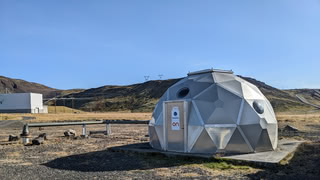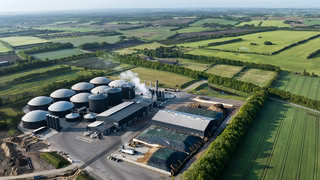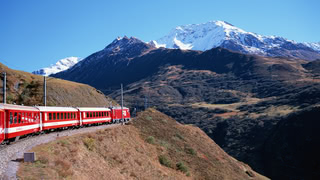Shipping Carbon Emissions from Switzerland to Iceland
Is it feasible to transport carbon dioxide over long distances for geological storage? Researchers from Switzerland think so — and have already started shipping CO₂ to Iceland in a pilot project.

Like most of its European neighbors, Switzerland plans to become carbon neutral until 2050. However, even when decarbonizing energy and transport, there will likely remain emissions from industries and agriculture in Switzerland that are hard or impossible to avoid with existing technology.
Researchers from the DemoUpCARMA project at ETH Zürich expect that in 2050, these sectors will still emit around 10 million tons of carbon dioxide, down from today's approximately 37 million tons. There are currently no carbon dioxide storage sites in Switzerland, and the researchers do not expect them to be available any time soon.
To tackle these emissions, the researchers have a bold plan: Carbon dioxide from Swiss industries could be stored 3,000 kilometers away in Iceland. They have already started shipping the first containers.
In Iceland, the company Carbfix operates a successful carbon capture and storage (CCS) project where emissions from geothermal plants and the world's largest direct air capture facility are stored underground. The carbon dioxide gets dissolved in water and reacts with basalt formations. The carbon is effectively stored in rocks, safe for geological timeframes.
Carbfix is not the only company that wants to store emissions from international industries. The Northern Lights project in Norway has similar plans. However, according to Marco Mazzotti, the scientist who led the DemoUpCARMA project, at the time they wanted to start, Northern Lights was not ready to offtake carbon dioxide. "The only storage site available for us immediately was Carbfix," said Mazzotti.
From a Biogas plant in Bern to Iceland
The carbon dioxide comes from a biogas plant in a wastewater treatment facility in the Swiss city of Bern. Biogas is a mixture of methane and carbon dioxide. To inject the methane into the gas grid, the two gases need to be separated. This process results in almost pure carbon dioxide, which is usually considered a waste byproduct. Due to the high CO2 concentration such biogas upgrade facilities generate, it is easy to capture.
The fact that the source of the carbon dioxide is biogas means that the project can deliver negative emissions, as the carbon is of biogenic origin.
Capturing emissions from other industrial facilities would, in many cases, be more challenging because the carbon dioxide content in the flue gas is often relatively low. Capturing such emissions would require an additional, energy-intensive step to separate carbon dioxide from the rest of the flue gas.
The carbon dioxide in Bern gets liquefied and stored in standard ISO tank containers, also called ISOtainers. Each container has a capacity of around 20 tons of carbon dioxide. By truck and train, the containers are delivered to Rotterdam, where they are shipped 2,200 kilometers to Iceland. The logistics company Samskip handles the shipping.
Carbfix operates multiple injection sites at the Hellisheiði geothermal power plant. At a new injection site near the town of Helguvik, Carbfix tests a new method of carbon dioxide injection with the Swiss emissions that uses saltwater instead of freshwater.
A project like this raises obvious questions: Does it make sense to transport carbon dioxide thousands of kilometers, and what are the emissions caused by the infrastructure needed to do that?
Marco Mazzotti says he does not have an answer to that, but it is part of what they are trying to find out with the project. He hopes that the efficiency of the complete infrastructure chain will be in the range of 80 percent, meaning that for every ton of carbon stored, around 200 kilograms of carbon dioxide are emitted both due to losses and the emissions caused by the energy needed for the liquefaction, transport, and storage infrastructure.
Emissions caused by trains and ships
Most emissions are caused by the train transport — it passes through Germany, which still has relatively high emissions per kilowatt hour — and the shipping. Decarbonizing the transport sector will, therefore, help bring down those emission losses. Carbfix says it plans to receive carbon dioxide with ships powered with green methanol in the future, but it has no timeframe yet for when that will be possible.
The DemoUpCARMA project aims to ship 1,000 tons of carbon dioxide annually to Iceland. With 20 tons per container, that equates to around one container per week. That sounds quite feasible. However, it gets much more challenging when the amount of carbon dioxide increases.
Transporting the emissions of a single cement plant — of which Switzerland has six — would require more than 25.000 containers per year (assuming 500,000 tons of annual CO2 emissions, which is plausible for a medium-sized cement plant). Alternatives like pipelines on land and dedicated carbon dioxide tanker ships could be an option for large-scale carbon dioxide transport.
The Danish company Dan Unity, which also partners with Carbfix, plans to build carbon dioxide tankers with a capacity of 22,000 cubic meters. They could transport around 25,000 tons of carbon dioxide. Dan Unity is owned by the shipping companies Evergas and Navigator Gas, both of which have experience shipping liquids and gases for the chemical industry. It would require around 20 shipments per year with such a carbon dioxide tanker to transport the emissions of a cement plant.
To get an idea of the scales needed, Mazzotti compares the expected 10 million tons of carbon dioxide that Switzerland intends to store in CCS projects to today's oil imports in Switzerland. Those are between 11 and 12 million tons – also in large parts transported by trucks and trains.
The experiences of the DemoUpCARMA project also highlight some of the regulatory challenges such projects could face. Iceland has implemented the EU CCS directive, but that would only apply if the project stored more than 100,000 tons. According to an interim report by the project, the Icelandic Environmental Protection Agency had concerns about how the imports should be regulated and whether they are a chemical product or waste.
This held up the transport of two containers that were already in Reykjavik. Eventually, the issue was resolved. "The Agency agreed to exempt the CO2 from Icelandic waste regulations as it 'belongs' to a research project," according to DemoUpCARMA's report. Such challenges highlight that until now, international carbon dioxide emission transport has almost never happened, and regulatory agencies have no experience with it.
An Import Terminal for Carbon Dioxide
The Icelandic company Carbfix expects that the business of importing carbon dioxide will grow. It plans to build a dedicated carbon dioxide import terminal. This project, the Coda terminal, has received a grant from the EU Innovation Fund. The EU will support the project with 115 million Euros.
Companies within the European Emission Trading System (ETS) can avoid paying for emission allowances if they avoid their emissions with CCS systems like the one provided by Carbfix.
In 2026, Carbfix expects to import 500,000 tons of carbon dioxide annually with one ship in operation. By 2031, the plan is to import three million tons per year with five ships.
Epilogue
This article was originally written in 2023 and published on the shipping news web page Fathom World (Mar 26 2023).
DemoUpCARMA's reports and published research papers can be found on the project's web page. Another research project from ETH Zürich named CiTru, involving some of the same scientists, is currently preparing tests for CO₂ injections in geological formations within Switzerland.
The city of Zürich plans to implement CCS at a sewer sludge waste incinerator. In a referendum in 2024, 75 percent of voters supported the plan. If things go as planned, emissions from the Werdhölzli incinerator and a biogas plant will partly be shipped to the Grønsand CO₂ storage site in Denmark and partly be stored in old concrete by the company Neustark.
Neustark has developed a technology to store emissions in demolished concrete. I covered Neustark's technology in a previous newsletter. Marco Mazzotti has since left ETH Zürich and is now working for Neustark.
The mentioned Northern Lights CCS project in Norway has recently announced an investment decision to expand its storage capacity from 1.5 million to 5 million tons annually.
Author: Hanno Böck
More
In 2022 and 2023, I covered alternative shipping fuels and carbon dioxide shipping projects for the shipping news web page Fathom World, which is no longer online. I plan to re-publish those old articles one by one with minor corrections and updates.
Apart from the article above, I also uploaded a text about methanol production pathways from biomass and waste. Reviewing these old articles is a good opportunity to check what happened to some of these projects announced a few years ago.
I had mentioned Enerkem's project in Spain, which I also covered in my last newsletter. It recently got an investment decision. I also had mentioned a company called Vordinborg Biofuels in Denmark that has since been renamed to Green2x and has pivited to biomethane. You can find more details in an update section at the end of the article.
Update on EU Green Electricity Certificates
It has been a while since I last covered guarantees of origin, the EU's flawed green electricity certificates. Companies from Norway long had concerns that the flourishing sale of these certificates from Norway's hydropower plant may impact their ability to claim that they are producing with green electricity. In a remarkable statement, Norway's government signals to its industry that it is free to claim that it uses clean electricity. Effectively, Norway makes double counting of green electricity official.
The European Commission writes in its recently published European Steel and Metals Action Plan: "Similarly, greenwashing can occur through carbon accounting practices, such as energy-intensive metals production benefiting from market-based instruments to appear low-carbon while still relying on high-emission energy sources or misleading scrap content accounting practices."
This sentence appears in a chapter about the EU's Carbon Border Adjustment Mechanism for imports (CBAM). A remarkable statement considering the problems of the EU's own market-based instruments like guarantees of origin.
I have covered Guarantees of Origin in multiple articles, and also made a video. You can find an overview here.



